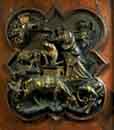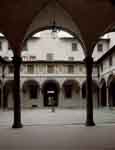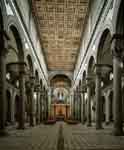 Filippo Brunelleschi was born in Florence in 1377. He was apprenticed as an artist by a goldsmith and two works of his are two Fathers of the Church and two busts of Prophets for the silver altar of the Duomo of Pistoia.
Filippo Brunelleschi was born in Florence in 1377. He was apprenticed as an artist by a goldsmith and two works of his are two Fathers of the Church and two busts of Prophets for the silver altar of the Duomo of Pistoia.
In 1401 he became well known thanks to a competition for the second bronze door of the baptistery of Florence. He was awarded a joint prize with Lorenzo Ghiberti, the author of the work.
A dramatic contrast is achieved by the intense movement effect of Brunelleschi’s tile, showing the Sacrifice of Isaac, and the serene classical-style tile by Ghiberti, which shows the same subject.
Other works of sculpture by Brunelleschi include the wooden Crucifix of Santa Maria Novella, made between 1418 and 1420, with perfectly harmonious proportions. It was a clear reaction to the Crucifix by Donatello in the church of Santa Croce, which Brunelleschi considered too crude and peasant-like.
 In 1418 the Guild of Wool called for proposals for the dome of Santa Maria del Fiore. This was a challenging project because the height and width of the building made the use of scaffolding set on the ground impossible. Brunelleschi designed a special wall structure with bricks laid out in a fish-bone arrangement: this meant the structure could be made higher with no additional support. He also divided the dome into eight parts by designing an ogival ribbed vault for it. The division into eight parts allowed to build the dome easily onto the previously existing octagonal tambour.
In 1418 the Guild of Wool called for proposals for the dome of Santa Maria del Fiore. This was a challenging project because the height and width of the building made the use of scaffolding set on the ground impossible. Brunelleschi designed a special wall structure with bricks laid out in a fish-bone arrangement: this meant the structure could be made higher with no additional support. He also divided the dome into eight parts by designing an ogival ribbed vault for it. The division into eight parts allowed to build the dome easily onto the previously existing octagonal tambour.
On the highest part of the dome is the lantern, shaped as a small temple, the pivot of the whole building.
Brunelleschi’s architecturalstyle is rigidly rational, based on perspective linearism and clear modulation of space. An example is the balcony of the Innocents’ Hospital, built by the artist between 1421 and 1424. The clear, linear and simple design is a novelty for the time.
In about 1423 Brunelleschi started working on the construction of the church of St Lawrence, which was  finished in 1428 with the Sacristy. The church has threenaves divided by round arches, which match the motive of the Balcony, creating an illusion of depth. The Sacristy is a cubic room with a hemispherical dome divided into twelve parts.
finished in 1428 with the Sacristy. The church has threenaves divided by round arches, which match the motive of the Balcony, creating an illusion of depth. The Sacristy is a cubic room with a hemispherical dome divided into twelve parts.
Between 1430 and 1444 Brunelleschi built the chapel in the cloister of Santa Croce for the Pazzi family. It has a rectangular plan with a central area and two side areas. The front portico was built by a pupil of Brunelleschi after his death but it was never finished.
In 1444 Brunelleschi started working on the church of St Spirito, an imposing and monumental building.
Filippo Brunelleschi died in Florence in 1446.